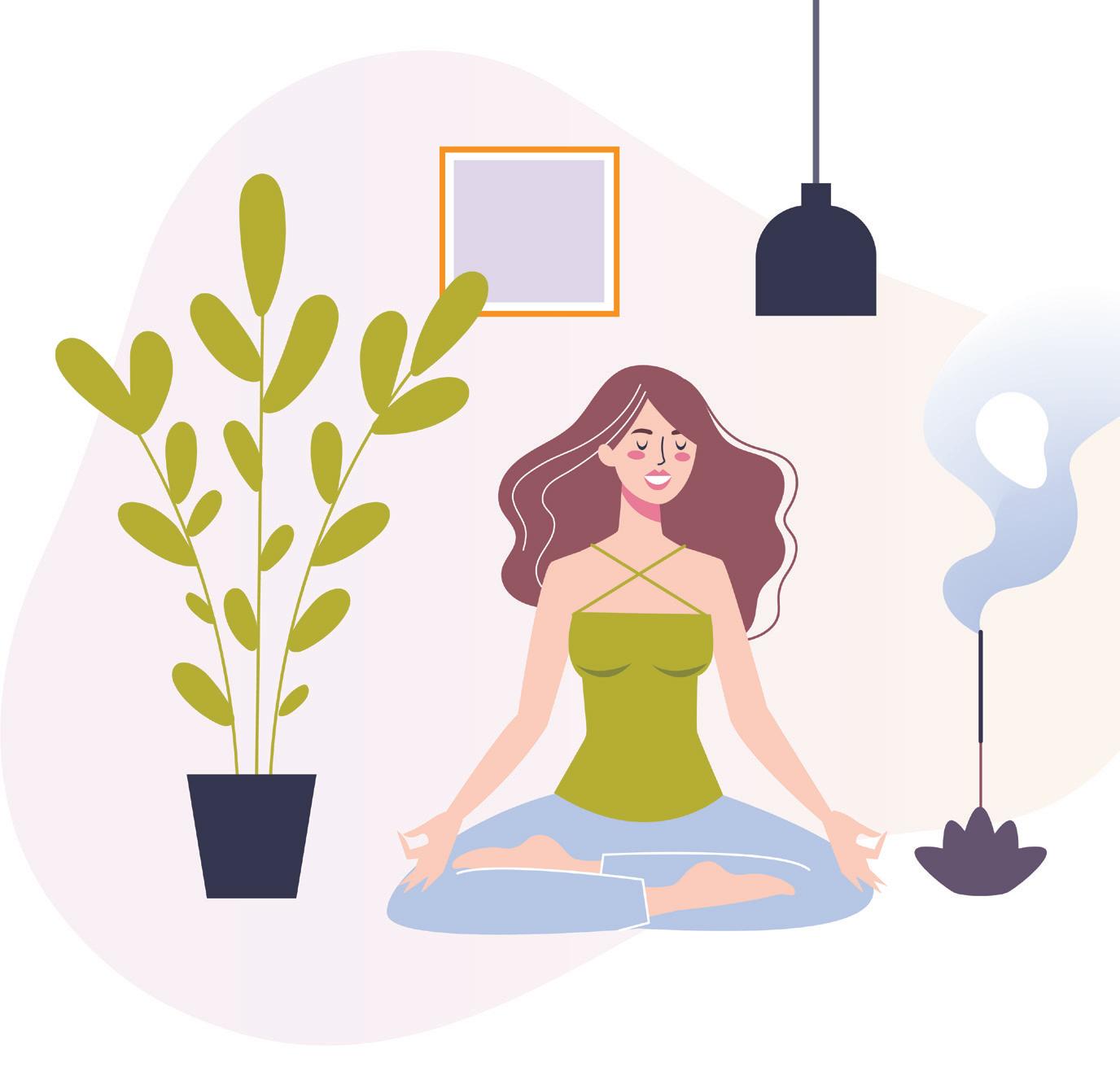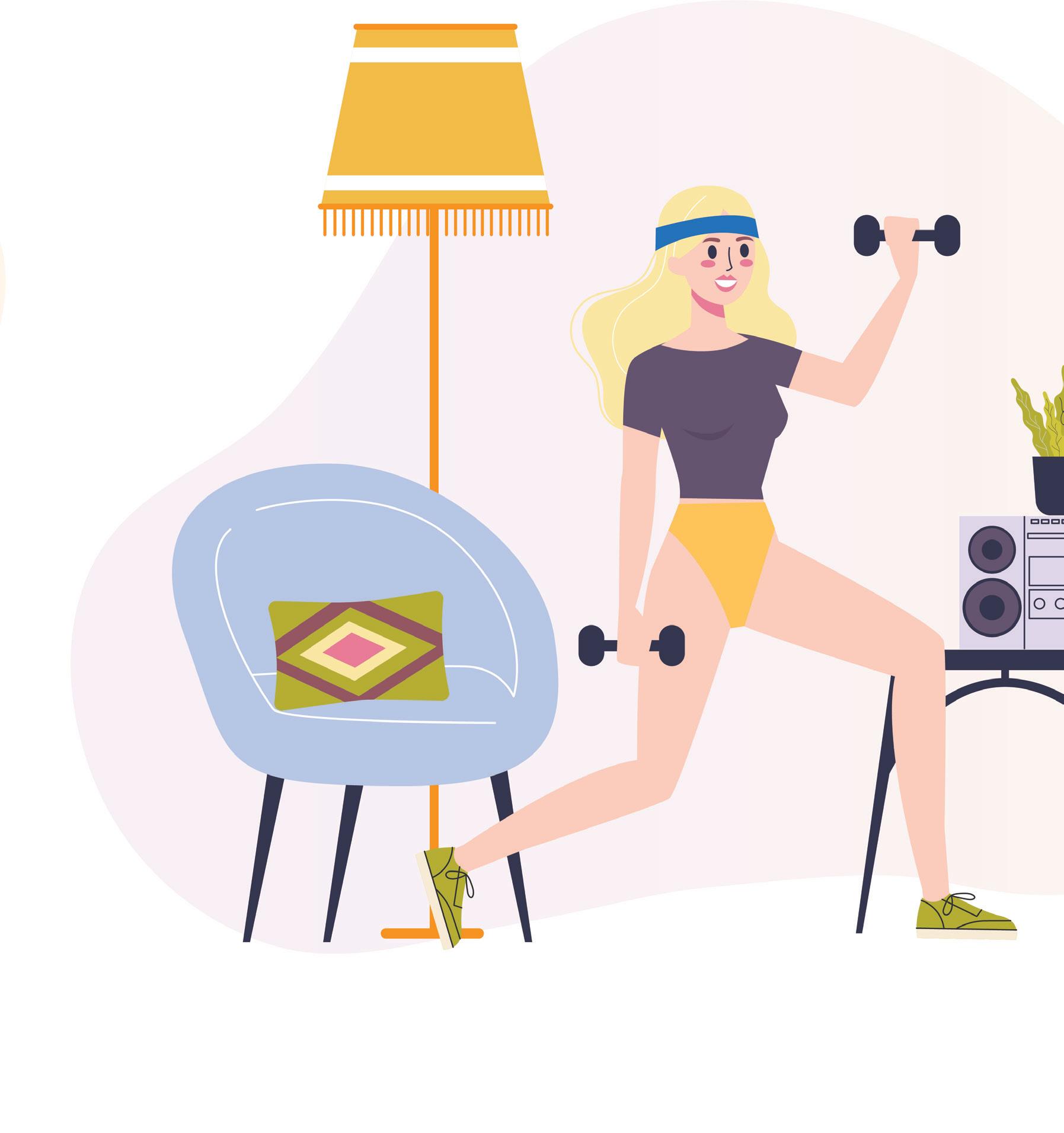
13 minute read
Special ANF Fitness Feature
Keeping in shape during COVID-19 and beyond
Here at western nurse we’ve researched some of the best home training tips around – including from Arnold Schwarzenegger! Whether it’s for this period of self-isolation, future restrictions, or just because you and your family have discovered you enjoy the convenience of training without driving to the gym, read on and enjoy.
Self-isolation can be frustrating, but it’s also an opportunity to discover new ways to stay or get fit.
Significant results are possible without any equipment, or with just a few items, such as a pair of dumbbells and an exercise bike.
In this edition of western nurse, we run through three levels of training, lighter home and garden activity, short traditional exercise routines and also fitness at home with equipment.
It’s important to get your health checked before setting out on any strenuous program. But lots can be achieved without putting yourself through torture and stop if you feel joint pain. Keeping moving and consistency over time are key to gains.
Routine is an important factor for facilitating consistent exercise. So:
Try to put aside the same time each day and also the same amount of time – even if it’s just for a certain period, such as a period of shifts.
If you can, also designate a place specifically for your exercise. Don’t worry if you don’t have a lot of space. Dr Kianoush Missaghi, a training specialist at the German fitness app Freeletics, recently told GQ UK magazine, that as little as two-by-two metres will suffice for a home workout area.

USING WHAT’S AROUND TO STAY ACTIVE
The Australian Heart Foundation reinforces the theme of keeping on the move to stay healthy and suggests you:
Catch up on gardening
Use an exercise bike or a swimming pool if you have these.
Develop your own short exercise routine and do it several times a day, for a total of at least 30 minutes.
Use YouTube to find a home workout that suits your needs.
Declutter your house.
Paint a room or restore a piece of furniture.
Restore any rusty bikes around your home.
Practise your golf-putting skills.
Play indoor bowls, if you have room.
If you can access an activity tracker, watch your steps – aim for 10,000 a day. Perhaps introduce a ‘most steps/active minutes challenge’ with family or friends.
Sit less. Avoid sitting for long periods. Break it up by moving about the house and set timers or reminders so you get up and move.
The Australian Heart Foundation says children aged five years to 17 need at least an hour a day of moderate physical activity and “more is better”. TV or movie sessions can be broken up with some fun activities with the kids. Examples include:
Play catch or handball in your driveway or other outside areas.
Devise your own outdoor games.
Use hula hoops, or practise juggling with the kids.
Play your children’s favourite music and dance together.
Play backyard cricket.
Play the Twister game or Wii Sports.
Have a family competition where you use a tennis ball to knock over plastic bottles filled with water.
Climb trees or swing on monkey bars.
Build a cubby house together using re-purposed materials from around the house and yard.
Get kids helping with gardening or housework.
TRADITIONAL EXERCISE
The Australian guideline for adults is to build up over 150 minutes a week of moderate intensity physical activity, says the Australian Heart Foundation. That should be the equivalent of a brisk walk – “enough to make you puff a little, but still be able to conduct a conversation”.
Muscle strengthening exercises are recommended for at least two days each week. For strengthening muscles and bones, the foundation recommends skipping, yoga jumping, push-ups, sit-ups, lifting weights, lunges and squats.
You can do:
Water bottle weights workouts. Fill a water bottle, milk carton or similar with water and use them as light weights in various movements.
Resistance exercises. Do them against a wall or chair.
Push-ups, sit-ups or half-squats. Do these during TV ad breaks.
A simple program of yoga and exercises. Combine yoga, step-ups using a makeshift step, modified push-ups or sit-ups, lifting weights, lunges, calf raises and half squats.
The British Heart foundation suggests the following heart-healthy workout. But if you haven’t done much exercise in a while, perhaps first ease into training by building in 10 minutes of activity each day. You can start with gentle activities such as walking, gardening or climbing stairs.

The routine can be done with each movement executed for 30 seconds at a moderate intensity. Then you rest for 30 seconds, and repeat the same exercise. After that move to the next exercise. When exercises get easier, increase the number of times you repeat each, and/or increase the time spent doing it. Or, decrease time spent resting between exercises and/or add more exercises. Do these on the floor or with a gym ball. Focus on keeping your back in a neutral position, contract your stomach muscles, lift your shoulders and curl your chest towards your knees. Then slowly lower to start position. Remember to breathe out and squeeze your abs on the way down.
2. Squats
Standing with feet slightly wider than shoulders, engage your stomach muscles, keep your back straight and lower your bottom as if you are going to sit on a chair. After that, come back up to standing. Breathe in on the down motion and out on the way up.
3. Jumping jacks
Stand with feet together and arms by your side, and jump in the air, split your legs and raise arms so you look like a star shape. Jump again to return to the first position. Repeat continuously, keep breathing. Keep knees slightly bent at all times. But watch your knees if you have joint issues.
4. Punches
Stand with feet shoulder-width apart. Make a fist, bend your arms with elbows at your waist. Extend one arm in front of you at shoulder height. Return to starting position. Repeat with other arm. Breathe out on each punch.
5. High knees
Jog on the spot and raise knees to waist height so your legs are pumping up and down. Keep stomach muscles engaged to help keep your balance. Remember to keep breathing. Again take care if you have joint issues.
ARNOLD'S HOME EXERCISE PLAN

Bodybuilding legend Arnold Schwarzenegger said on US website Reddit in March: “Even without a gym, we can also control our physical fitness during this pandemic. Body weight, or freehand training is the oldest method in the world … I started my own fitness journey with chinups on a tree branch by a lake in Austria.”
The 72-year-old Hollywood star gave his fans his own home workout, stressing if an exercise says 50 reps (repetitions), you need to get that amount, “however you can”. That’s whether it’s “10 sets of five reps, five sets of 10 reps” or “two sets of 25 reps”. Once you complete those reps, move on to the next exercise.
Arnold adds: "You can do it every other day and it will cover all of your muscle groups."
Push-ups. Beginner: 25 Reps. Advanced: 50 Reps Dips between chairs. Beginner: 20 Reps. Advanced: 50 Reps Row between chairs. Beginner: 30 Reps. Advanced: 50 Reps Sit-ups. Beginner: 30 Reps. Advanced: 100 Reps Bent-leg raises. Beginner: 25 Reps. Advanced: 50 Reps Bent-over twists. Beginner: 25 Reps. Advanced: 50 Reps Knee bends (squats). Beginner: 25 Reps. Advanced: 50-70 Reps Calf raises. Beginner: 25 Reps. Advanced: 50 Reps Chin-ups. Beginner: 10 Reps. Advanced: 30 Reps Demonstrations of each exercise are at this link:
https://imgur.com/gallery/yYmEOnO?s=sms
FITNESS AT HOME WITH EQUIPMENT
This stops short of a full home gym, but is for ANF members who are either already a little bit hardcore with exercise, or just didn’t put everything out for verge collection last time you dumped a fitness kick.
Yoga mat. “Yoga blocks and a mat is plenty to get a good home workout in, there is so much you can do with these,” says Marine Constant, climbing yoga teacher at Westway Climbing, a rock climbing gym in London. “You can work on strength, flexibility, cardio and mindfulness without breaking the bank. There are plenty of videos on YouTube to follow along to, from beginner to expert. Staying healthy from home doesn’t have to be complicated.”

Skipping rope. James Stark, a personal trainer and co-founder of Bristol-based gym chain Starks Fitness, says if your ceiling height permits or you’ve got a decent garden, use a skipping rope. “They’re very cost efficient, they’re very easy to come by,” he says. It’s probably not worth paying a fortune for a fancy weighted one or something with rotating handles. “Those are probably for people with a bit more experience skipping … Initially you just need a decent quality standard skipping rope which can be adjustable based on height. If you get good at skipping rhythm then you can master some of the drills.”
Stationary bicycle. “Cycling is not only fun, it’s a way to look good and feel good. Whether it be on the road or on a stationary bike, we’re cycling towards better brain and heart health,” says the American Stroke Association. The Mayo Clinic website says: “Studies have found that cycling indoors for 45 minutes, three times a week can raise HDL cholesterol (the good kind) and lower body fat percentage in just 12 weeks.” The website adds: “Cycling outdoors or indoors is a great way to get your heart pumping while putting minimal impact on your joints.”
It provides “a great cardio workout that challenges your legs and core muscles” and “has been proven to benefit folks who have osteoarthritis". So when “your joints can’t take the impact of running or walking, cycling can help decrease pain and increase your aerobic capacity”.
Pair of dumbbells. “A pair of small dumbbells should definitely be in your home equipment arsenal,” says Angela Ioannou, area fitness manager and personal trainer at the UK’s Everyone Active. “One, two and five kilogram dumbbells are a great weight to add additional resistance to exercises like lunges, side raises, bicep curls and tricep extensions. You don’t need to go heavy, if you keep your repetitions strict then you can get an amazing full body workout with them. Adjustable dumbbells are an amazing alternative, as you can create one heavy dumbbell and use for unilateral training, overloading one side.”
If you haven’t got dumbbells, tins of beans and other items might come in handy. “Large bags of rice or sugar can even be used to make any exercise that bit more difficult,” Ioannou says.
“Combine weighted squats with shoulder presses, lunges and upright rows, press-ups and bent over rows for a full body workout that, when done in quick succession, will be sure to get your heart racing.”

Swiss ball or exercise ball. “I’d say a Swiss ball is probably my top pick for home workouts,” says
James Stark. “There’s a lot of different exercises that can be done with a Swiss ball, especially stuff that’s core based. They generally come in 55cm, 65cm, or 75cm. You can work out whether you’re short, medium or tall to choose which one you need.” Nigel Stockill, performance director of fitness company Firstbeat, says: “A Swiss ball can provide you with a slightly unstable but safe and fun platform to sit on, lie on, stretch on, push and lunge from.”
Weighted vest. Bodyweight workouts like press-ups and squats are some of the easiest workouts to do at home because they don’t need any equipment. However, for those accustomed to lifting at a gym, they don’t really cut the mustard. Why not consider a weighted vest? They are compact enough to be easily delivered and can be used for all the same exercises as hand weights or kettlebells, and more. And they also keep your hands free. The weight of the vest is generally created with small sand bags weighing about 300g which can be added or removed, allowing you to customise your workout, and add more when things start getting easier. Great for squats and press-ups. Of course, staying in shape and maintaining good health also heavily depends on having a healthy diet with smaller portions.
Staying away from the gym can even help you lose weight. How? The answer is simple: Training in a gym makes many people think they need to eat more.
They start to believe they need extra protein to build muscle or the suchlike. That might be true for bodybuilders or competitive sportspeople, but for most of us, the reality is we already eat too much, whether or not we think it’s “healthy”.
Kettlebell. “The kettlebell is one of the most versatile pieces of equipment out there,” says Tommy Wanless, head of training at UK group training outfit, Speedflex. “Training the whole body, it is great for building muscle and also working your cardiovascular system – really getting the heart pumping.” Wanless recommends using a kettlebell for squats, deadlifts, swings, and shoulder presses to start with, before graduating to more complex moves like the clean and press, and snatches. “An eight to 12kg kettlebell will be plenty for most exercises,” he says. If you don’t have a kettlebell, Wanless suggests using a rucksack or other bag with packs of sugar or rice in them. He added: “Creating a distance between the weight and the handle is key to having the weight offset – to recruit those extra stabilising muscle groups.”
Resistance bands. They’re hugely popular and so portable. These large elastic bands can be used to exercise all areas of the body, says the British Heart Foundation. They can be good for people with limited mobility, because many of the exercises can be done either seated or standing. Among movements that are possible with the bands are lateral raises, squats, seated or standing chest presses, leg presses, bicep curls, seated calf presses and tricep presses.

A tablet or laptop. You might not be able to go to a gym or a trainer, but they might be able to come to you via the Net, if you have a tablet or other device with access to social media. Gyms are jumping online to offer livestreamed training classes via social media and YouTube is full of fitness videos. You might also consider getting on social media and exercising alongside friends, virtually. So rather than a video chat, have a video workout session with your besties.
BEYOND THE LIVING ROOM
Of course the next step can be a fully-equipped home gym. But as you can see, you can do so many different kinds of exercise with very little or no equipment. So removing another motivation for eating too much (eg: not eating that “healthy” burger that was to provide allegedly necessary extra protein) is a great move for weight loss.
Also, it’s just really inefficient to try to lose weight through exercise alone. Professor Paul Gately, of the Carnegie Weight Management institution in Leeds, put this theme into context in The Guardian newspaper a few years ago.
“It’s simple maths. If you want to lose a pound of body fat, then that requires you to run from Leeds to Nottingham, but if you want to do it through diet, you just have to skip a meal for seven days,” he said.









